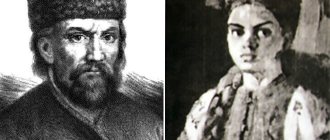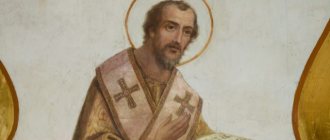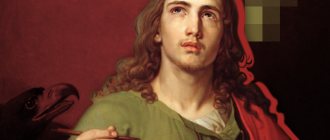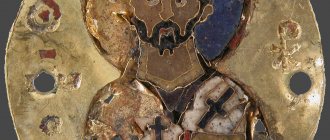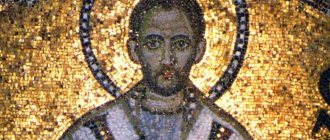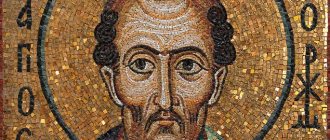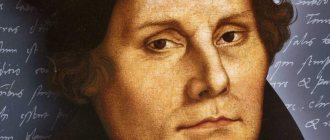Each icon in the house is part of some Orthodox history. The icon of the three saints is known; it is also called “The Council of the Three Hierarchs”. What kind of icon is this, and who is depicted on it? We will analyze this in detail in our article.
Lines from the akathist in honor of the three ecumenical teachers Gregory the Theologian, Basil the Great, and John Chrysostom:
“...Hearing your God-inspired words, imprinted with many deeds and sufferings, thirsty for the words of eternal life coming to you from afar, and receiving incorruptible food from you and drawing Divine drink, I cried out to you..."
Icon of the Three Saints
The icon of the three saints is very important for the Russian Orthodox Church
It depicts three great spiritual teachers of all times - Saint Basil the Great, Saint Gregory the Theologian and John Chrysostom. Why are the three of them depicted on the icon? After all, there are icons where all the saints are depicted separately.
Basil the Great, Gregory the Theologian and John Chrysostom. Photo: images.glavred.info
There are icons where all the ecumenical saints are depicted separately. But here the three of them are depicted, since it was they who left a great contribution to the Russian church. The saints were ecumenical teachers; they compiled the orders of worship in the church, church calendars, and prayers.
History of the creation of the icon
Many historians of Christianity and famous theologians agree that the icon of the Holy Family is actually a simple painting based on biblical motives.
Italy is considered the birthplace of this image. The painting was painted in the style of the great artist Raphael and became widely known in Italian lands. Later the painting was brought to Russia. This image is especially revered in the Israeli lands, which is why a tradition arose to honor this painting like an icon. Later, in the likeness of the painting, an Orthodox image was created, in the manner of icon painting in which Catholic traditions are discernible. Another icon, created on the basis of the image of the “Holy Family”, in the Orthodox tradition is called the icon of the “Three Joys”.
In the circles of clergy of the Orthodox Church there is still no consensus on the attitude towards the image of the “Holy Family”.
The icon depicts the saints in full growth
John Chrysostom
Let's analyze the images in detail. On the icon the saints are depicted in full growth. Very rarely they are depicted waist-deep.
On some icons you can see the Mother of God with the Child above their heads. This shows the patronage of the Mother of God and Her Son.
An icon of 3 saints, where the Mother of God with the Child of God is depicted above the heads of the saints. Photo: i1.stat01.com
The saints are depicted in dark red or gray robes. Each of them holds a cross and the Gospel in their hands. Their faces are stern.
What does the image of the “Holy Family” look like?
The original painting depicts Joseph the Betrothed, the Blessed Virgin and the Child of God. Many theologians reproach the author of the Catholic painting for deliberately distorting reality:
- Joseph was no longer young at the time when the Son of God appeared to the world, and in the picture he is depicted quite young;
- in addition, it is known that the relationship between Joseph and Mary was more like patronage than an equal marriage;
- According to church tradition, Joseph the Betrothed was betrothed to the Virgin Mary, but was not Her husband. In the picture, Joseph hugs the Most Pure Virgin by the shoulders, which is unacceptable for the canonical depiction of people who are not officially married.
The Orthodox image of the “Three Joys”, created based on this painting, was written in accordance with all canonical norms. On this icon, Joseph is depicted as a senior adviser and wise mentor to the Most Pure Virgin, called upon to protect and instruct Her, without being Her husband in the physical sense of the word.
The Sacred Family and Three Joys icons emphasize the importance of care and mutual respect in marriage. A good husband, like the wise Joseph, must treat his wife with care, care for her and protect her.
Priests remind believers that they should be wary of such images. You should look at the problem more broadly, see not only the image of a happy family, but also remember the Gospel story about these events. The story of Joseph and Mary is much deeper than the story of a happy and beautiful married couple. This is an ode to morality, spiritual work, wisdom, respect and trust. And, of course, at the head of the union of Joseph and Mary was a deep and sincere faith in the Almighty, the desire to live a godly life.
An icon with three saints should be in the home of every Orthodox Christian
An icon with three saints should be in the home of every Orthodox Christian. It creates the right spiritual mood in the believer.
At any time, a person can approach the icon and turn to the saints with his request. You can also put your request in your own words. The most important thing is to speak sincerely, from the bottom of your heart.
You can always turn to the saints for help in your simple words at home near the icons. Photo: playcast.ru
The meaning of the icon of All Saints
According to the letter of the Apostle Paul to the Ephesians, every person is given grace according to the measure of the Lord’s gift, and it can be worthy of both a righteous life and death for the glory of the Creator. It follows from this that holiness does not depend on whether the ascetic was recognized by the church - there are unknown martyrs and passion-bearers, information about whom has not reached our days. No less important were the acts of educators, sages, missionaries and rulers who contributed to the spread of the Christian faith - the icon of all saints reminds of them.
In addition, the relic is the personification of the Church Triumphant, or Heavenly. This is a gathering of all righteous followers of Jesus, led by the Savior himself. Such a congregation is free from misunderstandings, conflicts and disagreements, and is permeated with love, peace, mutual understanding and joy. In other words, the image demonstrates an ideal example of selfless service to the Creator, when any inequality and earthly differences lose their meaning.
An akathist is read before the icon of the three saints
An akathist is read before the icon of the three saints. It can be read not only on the day of remembrance of saints - January 30, but also on any other day. In the evening, light a lamp and stand near the image.
The icon can be placed in the red corner where the other icons are located. Mentally you can turn to the saints anywhere you are. You may be at work, at school, in the hospital. Contact us sincerely, and the three saints will definitely help you.
Saint Gregory the Wonderworker. How he met the Mother of God and John the Evangelist
Let us present part of this akathist.
Akathist:
Kontakion 1
Chosen luminaries of the Church of Christ, Basil, Gregory and John, who enlightened the world with your teachings
and all the vacillations of heresies and blasphemous confusions were extinguished; as the intercessors of our salvation, with your prayers preserve us from all troubles and eternal torment, and with joy we cry out to you in thanks:
Rejoice, three saints, great and universal teachers.
Ikos 1
Angels of earth and people of Heaven, the saints of Christ and the blessed fathers, champions of the Life-Giving Trinity, illumined by the trisolar light from Her and praying unceasingly at the throne of the Trinitarian Divinity for our souls, hear us calling from our hearts to you:
Rejoice, you who have the boldness to cry out to the Lord for us; Rejoice, great saints of the Holy Trinity.
Rejoice, you who have been granted integrity; Rejoice, apostle of uniformity.
Rejoice, for through your teachings the grace of Christ has been wondrously requested; Rejoice, having captured your mind in obedience to faith.
Rejoice, blasy worker of the grapes of Christ; Rejoice, blessed by God from your youth.
Rejoice, you who have endured the sorrows of this life well and have multiplied the talent given to you; Rejoice, having preached the will of God to the mighty of this world with much boldness.
Rejoice, having driven away the darkness of wickedness; Rejoice, having enlightened the entire sunflower with the dawns of dogmas.
Rejoice, three saints, great and universal teachers.
Kontakion 2
Seeing the heretical fierce aspirations, the sharpest sword against the networks of false teachings and fire, consuming the tares of superstition, Saint Basil appeared and, like a great shepherd, denounced the flattery of idols with his inspired broadcasting. We are taught to venerate the Holy Trinity, divided by the Hypostases but united by the Being, and cry out to Her: Alleluia.
Ikos 2
The mind is illuminated by the grace of Christ, as the apostle of oneness of equality, the Orthodox dogmas of the teaching have been clarified and the three great lamps of the Trinitarian Divinity have appeared; Illuminated by your inspired writings, the Church of Christ shines brightly, and its faithful children ascend to the measure of the age of fulfillment of Christ. In the same way, looking at the riches of the grace of Christ bestowed upon you, as our enlighteners we praise you, blatantly:
Rejoice, God-bearing heavenly mysteries; Rejoice, repentance and silence of the preacher.
Rejoice, vessels of election; Rejoice, teacher of wisdom of the universe.
Rejoice, you who have taught people in the Divine teachings of Christ; Rejoice, you who have always walked diligently in the commandments of the Lord.
Rejoice, having manifested many different virtues in your life; Rejoice, pillars of steadfastness, who have confirmed the faith of Christ with Divine dogmas.
Rejoice, the verbal flock of Christ wiser than those who fell; Rejoice, most distinguished theologians of Orthodoxy.
Rejoice, luminaries, enlightening all the ends of the earth; Rejoice, sweet-sounding pipe and lantern.
Rejoice, three saints, great and universal teachers.
Kontakion 3
The power of the prayers of his fathers forced Saint Gregory to leave Pontus and to Nazianz to his father, to help him, to settle down, where he taught and taught the glory of God and disgraced the Arian heresy. In the same way, great Saint Gregory, remember us, passing through the pastures of the Divine incorruptible paradise, at the throne of the Holy Trinity, and with tenderness we cry out to Her: Alleluia.
Ikos 3
Having in their hearts the luminous grace of the Holy, Consubstantial and Indivisible Trinity, the three preachers of God, the division of the body and the union of the spirit, piously preaching the One and Unchangeable Trinity, the Being and the Divinity, and sealing this sermon with suffering. Likewise, we, imitating their faith, cry out as follows:
Rejoice, strong and invincible supporters of the Church of Christ; Rejoice, zealous zealots of the truth of Christ.
Rejoice, warm prayer books to the Most Holy Trinity; Rejoice, good shepherds of the Church of Christ.
Rejoice, Aria, who deposed and established the Orthodox; Rejoice, One Unchangeable Trinity, Being and Divinity, having glorified by deeds and teachings.
Rejoice, Father, and Son, and Holy Spirit, Trinity Hypostasis, who have wonderfully understood; Rejoice, for the sake of the Tri-radiant One and the One Divinity, you have endured the greatest sorrow and persecution.
Rejoice, having borne the burden of the day unabated until the end of your life; Rejoice, having driven away the dark night of evil heresies with the rays of godly dogmas.
Rejoice, you who have nourished the souls of the faithful with grace; Rejoice, you have been deemed worthy to be the heir of the Eternal Kingdom.
Rejoice, three saints, great and universal teachers.
Kontakion 4
Raising a storm of rage and anger, O Chrysostom, the madness of people, slandering you and commandingly expelling you from the reigning city. But you, O Zlatoslova, abiding unshakably on the rock of the faith of Christ and strengthened by the grace of the Holy Spirit, you courageously endured the storm of persecution and torment
and through suffering you have prepared for yourself an imperishable crown in Heaven, teaching everyone to patiently bear the Cross of Christ and cry out to God: Alleluia.
Ikos 4
Hearing your God-inspired words, imprinted by many deeds and sufferings, thirsty for the words of eternal life coming to you from afar, and receiving incorruptible food from you and drawing Divine drink, crying out to you:
Rejoice, you who have experienced the depths of God’s word for good; Rejoice, having sought God through unceasing zeal.
Rejoice, nourishment of those who hunger for righteousness; Rejoice, comforter of the poor in spirit.
Rejoice, clouds that shed the dew of pious teachings and solder the universe; Rejoice, ever-flowing spiritual rivers, feeding the faithful children of the Church of Christ.
Rejoice, guardian of the Divine Mysteries and verbal trumpets of God; Rejoice, planter of the right faith and Christian piety.
Rejoice, you who illuminate many faithful miracles; Rejoice, you who pour forth rivers of healing for us.
Rejoice, you who diligently come to you from temptations and misfortunes through your prayers; Rejoice, the whole Christian family is praised.
Rejoice, three saints, great and universal teachers.
Kontakion 5
Christ showed you the godly star to the world, great in all hierarchs, Vasily; having acquired knowledge of the Divine Mysteries and illumination from above from the Throne of God’s grace, you have wonderfully enlightened the minds and hearts of the faithful with God-inspired words, and we animate persecution with love for God
and you endured suffering for Christ well, and for this sake you were vouchsafed in Heaven the boldness of prayer
at the Throne of the King of Glory, the image being faithful in word, life, spirit, love, faith and purity, so that everyone with tenderness cries out to the Most Holy Trinity: Alleluia.
Ikos 5
Seeing you, saints of Christ, ever abiding in heavenly countenance and always present before the Throne of God, with tenderness we glorify the Life-Giving Trinity, which glorified you by nature, by your word and life, but to you, a great prayer book, we cry out from the love of our hearts:
Rejoice, the heavenly face of copulation and the cohabitation of holy angels; Rejoice, to the Throne of the King of Glory, ever coming with all the elect.
Rejoice, adorned with the glory of heaven; Rejoice, you who hate the flesh and the world.
Rejoice, having put into your minds all the treasures of the world and the delights of life for Christ’s sake; Rejoice, having ascended to the luminous chariot of virtues and having reached the Heavenly Kingdom.
Rejoice, having shown us, sinners, the image of virtues in word and life; Rejoice, you who through many sorrows have entered into the joy of your Lord.
Rejoice, warm intercessors for us before God; Rejoice, Orthodox theology has been a great luminary.
Rejoice, Christian faith is praised; Rejoice, glory to the saints and adornment of the Church.
Rejoice, three saints, great and universal teachers.
This kontakion is read three times, then the 1st ikos “Earthly Angels...” and the 1st kontakion “The Chosen Lamp...”
By leaving a comment, you accept the user agreement
Iconography of the holy martyrs
With your venerable blood you have sanctified the land, and you have received an imperishable crown...
General service to the martyr, stichera on “Lord, I cried”
What amazing words we hear in the “Rite of the consecration of the temple, performed by the bishop”! For Thou art holy, our God, who resteth upon the honorable martyrs who suffered for Thee... The Lord establishes His temple—a heavenly House—on the holy martyrs.
The height of martyrdom becomes clear from the very meaning of the Greek word μάρτυς - “witness.” First of all, martyrdom is following the path of Christ, a repetition of the passion and atoning sacrifice of Christ. The Only Begotten Son of God appears as a prototype of martyrdom, testimony with one’s own blood - let us remember His answer to Pilate: For this purpose I was born and for this purpose I came into the world, to testify (μάρτυρήσω) to the truth (John 18:37).
This word also applies to the apostles - witnesses of the life and resurrection of Christ: having appeared to them after the resurrection, Christ says: You will receive power when the Holy Spirit comes on you, and you will be my witnesses (μάρτυρες) in Jerusalem and in all Judea and Samaria, and even to ends of the earth (Acts 1:8). V.V. Bolotov called martyrdom a continuation of apostolic service in the world: with the spread of persecution of Christians, the feat of witness is taken upon by martyrs who, by their voluntary death for the faith of Christ, testify to the victory of Christ over death.
The Holy Scripture contains a description of the feat of the first Christian martyr, Archdeacon Stephen. Standing before the Sanhedrin that condemned him, the first martyr Stephen, looking up to heaven, saw the glory of God and Jesus standing at the right hand of God, and said: behold, I see the heavens opened and the Son of Man standing at the right hand of God (Acts 7:55–56). By this, Stephen testified to the Kingdom of Heaven, which opened for him during and as a result of martyrdom. The martyrdom of Stephen itself resembles the passion of Christ. When they stoned him, he exclaimed in a loud voice: Lord, do not hold this sin against them. And having said this, he rested (Acts 7:60). Let's compare his words with what Christ said on the Cross: Father forgive them, for they do not know what they are doing (Luke 23:34). Beginning with Stephen, in their martyrdom they follow the path of Christ and all the witnesses are martyrs of subsequent times.
The first images of holy martyrs in the Christian tradition appear almost simultaneously with the development of their veneration. Initially, these were apparently gravestone images, the meaning of which was victory over death and salvation for the Kingdom of Heaven. Such evidence for early Christian art were Old Testament scenes: Daniel in the lions' den, the three youths in the fiery furnace, as well as Noah, the prophet Jonah and others.
The first images of martyrs themselves appear in martyriums - temples erected over the graves of martyrs. Early frescoes there depicted the holy martyrs in their glorified state - death defeated, eternal life triumphant. This was the iconography of the martyrs from the time of their establishment in the 4th-5th centuries. before the period of iconoclasm.
In the dome of the church of St. Great Martyr George in Thessaloniki (end of the 4th century), mosaic images of the martyrs Onesiphorus, Porphyry, Cosmas, and Priscus have been preserved. In combination with the image of Christ the Savior surrounded by angels with a cross in his hand, these images symbolized the Heavenly Jerusalem. Images of martyrs - witnesses of Christ's victory, occupy a strong place in the system of temple painting: in the Armenian treatise "Against the Iconoclasts", written at the beginning of the 7th century. Vrtanes Kertoch, along with the subjects of the Christological cycle, mentions the images of the prophets, apostles, Archdeacon Stephen and other martyrs present in the temple paintings.
Cycles of paintings of a historical nature, illustrating the life of the saint whose relics were in this building, appear already in martyriums. It is worth mentioning some features of the iconography of the martyrs of the early period. Almost all images, starting with the first martyr Stephen, have a cross. It is depicted in the hands of a saint and is a symbol of both the apostolic gospel and the symbol of sacrifice. The iconography of martyrs uses the color red as a figurative expression of suffering for the faith, and the red robes of martyrs are a symbol of shed blood. According to Tertullian, the blood of Christians was the seed from which faith grew.
As is known, from the reign of Emperor Decius (249-251) and up to the Edict of Milan in 313, the persecution of Christians was aimed not so much at executing Christians, but at forcing them to renounce - hence the sophisticated torture (and those who endured it were not always executed) , descriptions of which we find in many lives. The persecutions of this period, along with martyrs, produce many confessors. Primates of churches were primarily persecuted at this time.
The most severe persecutions were at the end of the reign of Diocletian (284–305) and subsequent years: a number of edicts were issued depriving Christians of all civil rights; All representatives of the clergy were imprisoned - they were required to renounce Christianity and make sacrifices. The Edict of 304 ordered all Christians everywhere to be forced to make sacrifices, using any torture. Martyrdom did not stop even after the Edict of Milan in 313, which proclaimed complete religious tolerance. Sufferers for the faith appeared under the Arian emperors in the Persian Empire, in various countries where Christianity collided with paganism, during the struggle between Islam and Christianity, etc.
After the end of the persecution, which developed in the 4th-5th centuries. the veneration of martyrs was regulated in a certain way. The celebration of the saint’s memory became a church-wide celebration; days of remembrance of various martyrs (dies natalis - birthdays for eternal life) were combined into an annual cycle, and martyrologies were compiled. A generally accepted iconography also developed.
The holy martyrs on icons appear not in their earthly service, but in their heavenly glory, standing before God in the Kingdom of Heaven. The hagiographical marks that appear later on the icons serve only as an addition to the main image, depicting the saint in glory. Certain types of images were developed, later (starting from the 16th century) recorded in iconographic originals.
The first images of holy martyrs in Rus' were images of saints in heavenly glory typical of Byzantine iconography of the post-iconoclast period. Here are some examples.
A mosaic image of the Great Martyr Demetrius of Thessalonica from the beginning of the 12th century, kept in the Tretyakov Gallery. from the cathedral church of St. Michael's Golden-Domed Monastery in Kyiv (exploded in 1935) is a full-length figure of a fully armed warrior in gold-colored armor, on a gold background. The Great Martyr Demetrius appears here not so much as a martyr, but rather as a courageous victorious warrior - the Slavic peoples revered him as their heavenly patron. Let us note that in the traditional iconography of the Great Martyr Demetrius - including in the Basilica of St. Demetrius in Thessaloniki of the 5th century, the great martyr was depicted in a tunic and a cloak with tavli.
The same goes for two icons of the Great Martyr George - from the Tretyakov Gallery and the Moscow Kremlin museums. The only difference is that instead of gold, these icons are characterized by the color red - martyrdom. But this is, first of all, a victorious warrior - the patron of the Russian army.
The Great Martyrs Demetrius and George, and other martyrs, are represented in a completely different way on icons with hagiographical marks. Here we see exactly what they overcame and at what cost. This is a clear illustration of life.
Great Martyr George was the son of rich and pious parents who raised him in the Christian faith. Having entered military service, the future saint, with his intelligence, courage, and physical strength, achieved the rank of commander and became the favorite of Emperor Diocletian, a talented ruler, but a fanatical supporter of the Roman gods. Diocletian tried to revive dying paganism in the Roman Empire and went down in history, as already indicated above, as one of the most cruel persecutors of Christians.
Foreseeing that suffering would also await him, George distributed his property to the poor, set his slaves free, appeared to Diocletian and, declaring himself a Christian, accused him of cruelty and injustice. The saint's speech was full of strong and convincing objections to the inhuman imperial decree on the persecution of Christians.
After unsuccessful persuasion to renounce Christ, the emperor ordered the saint to be subjected to various tortures. He was imprisoned, where he was laid on his back on the ground, his feet were shackled in stocks, and a heavy stone was placed on his chest. The ascetic bravely endured suffering and glorified the Lord. Then George’s executioners began to become more sophisticated in their cruelty. They beat the saint with ox sinews, wheeled him around, threw him into quicklime, and forced him to run in boots with sharp nails inside. The holy martyr endured everything patiently. Seeing the futility of further torture, the emperor ordered the saint’s head to be cut off with a sword. The Holy Great Martyr George departed to Christ in Nicomedia in 303.
The Great Martyr George is also called the Victorious for his courage and spiritual victory over his tormentors who could not force him to renounce the faith of Christ, as well as for his miraculous help to people in danger. The relics of Saint George the Victorious were in the Palestinian city of Lydda in a temple bearing his name, and his honorable head was in Rome in a temple also dedicated to him.
Traditional for Russian icon painting, the image of the Great Martyr George is sitting on a white horse and slaying a serpent with a spear. This image is based on legend and refers to the posthumous miracles of the Holy Great Martyr George: in the vicinity of the city of Beirut, a snake lived in a lake, often devouring the people of that area. To soften the fury of the serpent, superstitious residents began to make human sacrifices to him, and one day the lot fell on the daughter of the ruler of that area. She was taken to the shore of the lake and tied, where she waited in horror for the monster to appear. A warrior suddenly appeared on a white horse and struck the snake with a spear and saved the girl. This was the Holy Great Martyr George. With such a miraculous phenomenon, he not only stopped human sacrifices, but also converted the inhabitants of that country, who had previously been pagans, to Christ.
Saint George is also revered as the patron saint of the Russian army. The image of Saint George the Victorious on a horse symbolizes the victory over the devil - “the ancient serpent” (Rev. 12:3; 20:2). This image was included in the ancient coat of arms of the city of Moscow.
The icon of the Great Martyr George in the Life (early 14th century) from the State Russian Museum in the middle has an image of the Great Martyr slaying the serpent, and in the stamps there is a consistent story about the sufferings endured by the Great Martyr.
Icons of the Great Martyr Demetrius of Thessalonica, also from the beginning of the 14th century, from the State Museum-Reserve "Rostov Kremlin" and the Great Martyr Theodore Stratelates of the end of the 14th century. from the Novgorod Museum-Reserve are equally detailed (even the number of stamps is the same - there are 14 of them). In the middle are life-size images of saints.
Let us mention here the main points of the life of the Great Martyr Demetrius in order to make the plots of the icon’s marks clearer. The saint was born in the city of Thessaloniki in Greece; His parents, secret Christians, baptized him and instructed him in the faith. His father, the Roman proconsul, died when Demetrius reached adulthood. Emperor Maximian Galerius, who ascended the throne in 305, appointed Demetrius to replace his father as ruler and governor of the Thessalonian region. Demetrius's main duty was to defend his region from external enemies, but the emperor also demanded that he exterminate Christians. Demetrius instead began to eradicate pagan customs and convert pagans to the faith of Christ.
Of course, the emperor was soon informed that Proconsul Demetrius was a Christian. Returning from a campaign against the Sarmatians who inhabited the Black Sea steppes, Maximian stopped in Thessaloniki. Preparing for death, Demetrius distributed his property to the poor, and he devoted himself to prayer and fasting. The emperor imprisoned the proconsul and began to entertain himself and the inhabitants of Thessaloniki with gladiatorial battles in the circus. Christians were searched for and dragged into the arena. The German Liy, famous among gladiators, easily defeated meek Christians in battle and, with the rejoicing of the brutal crowd, threw them onto the spears of the soldiers.
Demetrius' disciple, the young man Nestor, visited Demetrius in prison, and the saint blessed him to fight Leah. Strengthened by God, Nestor defeated the proud gladiator and threw him onto the spears of the soldiers. Nestor should have been awarded as a winner, but instead he was executed as a Christian.
By order of the emperor, the prison guards pierced Demetrius with spears in 306. The body of the Great Martyr Demetrius was thrown out to be devoured by wild beasts, but the Thessalonians secretly betrayed him to the ground. Dimitri's servant Lupp took the bloody robe and the martyr's ring and began to heal the sick with them. He was also executed. During the reign of Emperor Constantine the Great (324–337), a temple was erected over the grave of the Great Martyr Demetrius, and a hundred years later his incorruptible relics were discovered. Miracles and healings were performed at the saint's tomb. During the reign of Emperor Mauritius, the Avars living on the Don besieged the city of Thessaloniki. Saint Demetrius appeared on the city wall, and the 100,000-strong army of the besiegers fled. Another time the saint saved the city from famine. The life of Saint Demetrius tells that he freed prisoners from the yoke of infidels and helped them reach Thessaloniki. From the 7th century fragrant and miraculous myrrh began to flow from the shrine of St. Demetrius, which was attested in the chronicle sources of that time. For this reason, the great martyr is called the Myrrh-Streaming One.
The Great Martyr Theodore came from the city of Euchait (in Asia Minor, now Turkey) and was a governor (in Greek - “stratilate”) in the city of Heraclea, near the Black Sea. With his pious life and meek leadership, he won over the hearts of the townspeople, and many pagans, seeing his virtuous life, accepted the faith of Christ. When rumors of this reached the Emperor Licinius (308–323), co-ruler of Constantine, he arrived in Heraclea and forced Theodore to worship idols. When Saint Theodore remained unshaken, the angry ruler ordered that the confessor of Christ be subjected to cruel torture.
Saint Theodore was stretched out on the ground, beaten with iron rods, his body was planed with a sharp iron, he was burned with fire, and finally he was crucified on a cross and his eyes were gouged out. At night, an angel appeared to the martyr, took him down from the cross and completely healed him. The next morning, the servants of Licinius, sent to throw the body of Saint Theodore into the sea, seeing him completely healthy, believed in Christ. Many other pagans who saw the miracle of God also believed. Having learned about this, Licinius ordered Saint Theodore to be beheaded, and he died in 319.
Martyrdom, of course, was not the lot of warriors alone. Saints who suffered martyrdom for confessing the faith of Christ in the priesthood are called holy martyrs. As a rule, the service of bishops during the early periods of persecution of Christians ended with martyrdom.
Icon of the Hieromartyr Charalampios, 18th century. from the Vladimir-Suzdal Museum-Reserve depicts the martyrdom of a saint who served in the second half of the 2nd century. bishop in the city of Magnesia, in Thessaly. He converted many of the pagans to Christ, instructing them on the path of salvation, teaching them the Word of God. For preaching the Gospel, the holy Bishop Charalampios was brought to trial before the ruler Lucian and the military commander Lucius. Threatening torture, they demanded that Bishop Charalampius make sacrifices to the pagan gods. In response, the saint firmly confessed his faith in Christ. Then Charalampius was subjected to severe torture. They hung him from a tree and whittled his body with iron hooks until the skin was torn off from head to toe. “Thank you, brothers,” said the martyr. “Having sharpened the body, you renewed my spirit.” The warriors Porfiry and Vaptos, who tortured the holy bishop, were so amazed by his gentleness and patience that they themselves openly confessed faith in the Risen Christ. Both of them were immediately beheaded by the sword. Together with them, three women were beheaded, who, like Porphyry and Vaptos, believed in Christ.
The military commander Lucius himself took the instruments of torture and cruelly tormented the body of Saint Charalampios, but suddenly his hands were lost at the elbows. Lucian, seeing this, spat in the face of the holy martyr Charalampios, and suddenly his head turned back to face him. Then the people, overwhelmed with horror, began to pray to the holy martyr to turn away God’s wrath. Lukiy also asked with them. Through the prayers of the holy martyr, Lucius and Lucian were healed. Then Luke also believed in Christ and was baptized. Many eyewitnesses also turned to the true faith of Christ, others received healing from various ailments through the prayers of the holy martyr Charalampios.
Lucian reported everything that had happened to Emperor Septimius Severus (193–211), who was in Antioch. The emperor ordered the saint to be brought to him. Fulfilling the order, the soldiers drove a sharp iron nail into the martyr’s body, wove a rope into his beard and, wrapping it around his neck, dragged him to the emperor. The emperor himself, seeing the saint, plunged three sharp stakes into the chest of the holy martyr Charalampius, and then ordered him to be fired over low fire. However, the power of God strengthened Saint Charalampios, and he remained unharmed.
Through the prayer of the holy martyr, miracles began to happen again. The saint expelled the devil from the man and raised the dead youth. The emperor himself was horrified, but soon became embittered again and subjected Saint Charalampios to other terrible torments. Seeing his patience, Septimius Severus's daughter Galina believed in Christ and began to convince her father of the truth of the Christian faith. Despite this, the emperor, after further torture, condemned the holy martyr to death - he was beheaded with a sword.
The icon marks shown here illustrate Lucius losing his arms and being tortured by slow fire: a certain woman decided to take part in the torture; she took a ladle, scooped up hot ashes and began to pour them into the eyes of the holy martyr.
The icon of the Hieromartyr Hypatius of Gangra from the collection of the Tretyakov Gallery was painted in the 16th century. in Tver. Saint Hypatius was the bishop of the city of Gangra in Paphlagonia (Asia Minor); in 325 he took part in the First Ecumenical Council in Nicaea, at which the heresy of Arius was anathematized. When Saint Hypatius was returning from Constantinople to Gangry in 326, he was attacked in a deserted place by followers of the schismatics Novatus and Felicissimus. The heretics wounded him with swords and stakes and threw him from a high bank into a swamp. Like the first martyr Archdeacon Stephen, Saint Hypatius prayed for those who were killing him. An Arian woman hit the saint on the head with a stone, and he died. The killers hid the body of the martyr in a cave, where it was discovered by a peasant who stored straw there. Having identified the body of the bishop, he hastened to report this to the city, and the inhabitants of Gangra honorably buried the relics of their beloved archpastor.
As you know, the persecutors of the faith of Christ did not spare either women or children.
One of the revered saints in Rus' has long been the Great Martyr Paraskeva. Icon of the 16th century. from the Dmitrov Kremlin and the contemporary Tver icon from the Andrei Rublev Museum reveal a picture of the martyrdom of the holy ascetic who suffered for Christ under the Emperor Diocletian. The Great Martyr Paraskeva was born in the city of Iconium in Asia Minor. Her parents especially honored Friday, when the Lord Jesus Christ suffered on the Cross. In honor of this day, they named their daughter Friday (Paraskeva in Greek). She was orphaned early. Having reached adulthood, Paraskeva took a vow of virginity and cared about spreading the faith of Christ among the pagans.
When the military commander of Emperor Diocletian arrived in the city, who was tasked with exterminating Christians, Paraskeva refused to sacrifice to idols and was tortured for this. They hung her on a tree and tormented her body with iron nails, and then, ulcerated to the bones and barely alive, they threw her into prison. God did not abandon the holy sufferer and miraculously healed her. The evil tormentor did not understand this miracle and continued to torture Saint Paraskeva, ordering her to be hanged on a tree and burned with torches. Finally they cut off her head with a sword. Christians buried the body of Saint Paraskeva; healings were given to the sick from the relics of the great martyr.
On an 18th century icon. from the Krasnodar Art Museum depicts saints who also suffered under Emperor Diocletian. Iulitta was a young widow of noble origin who lived in Iconium with her son Cyric. During the persecution, fearing torture, she left all her property and, with three-year-old Cyric, accompanied by two slaves, left Iconium and lived as a beggar wanderer, first in Seleucia, and then in Tarsus. During the persecution of Christians in Tarsus, Julitta was recognized and brought along with her son to the court of the mayor Alexander. Before the ruler, Iulitta confessed herself to be a Christian. She was separated from her son and subjected to scourging. Kirik, seeing his mother’s torment, cried, said that he was also a Christian, and demanded that he be allowed to see his mother. In anger, Alexander threw the child off the stone platform, and Kirik died. Julitta was subjected to new tortures (they whittled her body with iron teeth, poured boiling resin on her wounds), but she refused to make sacrifices to the pagan gods. Alexander sentenced the saint to beheading, which was carried out. The bodies of Kirik and Iulita were left by the executioners without burial outside the city, but Iulita’s slaves buried them secretly at night. The relics of the saints were later recovered and were kept in the Hagia Sophia until the fall of Constantinople.
It should be noted that the detailed, with many details, image of the “technology of torture” did not cause rejection in the viewer; it was not naturalistic, but contributed to the emergence of compassion. This tradition is becoming obsolete in later iconography; on a 19th century icon from the Rublev Museum depicts the Great Martyr Catherine with a scene of torment. The saint's wheeling is depicted so elegantly that the person praying in front of such an icon does not have any thoughts about the saint's martyrdom. Meanwhile, as the life of this wise bride of Christ testifies, they tormented her cruelly. The openwork wheel depicted on the icon was in fact a terrible instrument of torture.
We will conclude our brief overview of the iconography of martyrdom by saying that the twentieth century gave the world a host of witnesses - new martyrs and confessors who suffered for Christ. The glorification of the Council of New Martyrs and Confessors of Russia at the Jubilee Council of Bishops in 2000 opened a new page in the iconography of martyrdom.
Bishop Nikolai of Balashikha
Literature and sources:
Antonova V.I., Mneva N.E. Catalog of Old Russian painting of the 11th - early 18th centuries. (State Tretyakov Gallery). T. 1–2. M., 1963.
Iconographic original of the consolidated edition of the 18th century, edited by G. D. Filimonov. M., 1876.
Icons of Vladimir and Suzdal. M. 2006.
Icons of Yaroslavl 13–16 centuries. M., 2002.
Lazarev V.N. History of Byzantine painting. T. 1–2. M., 1986.
Lazarev V. M. Russian icon painting from its origins to the beginning of the 16th century. M., 1983
Mayorova N., Skokov G. Russian icon painting. Stories and masterpieces. M., [b.g.]
Features of correct prayer
- The main condition for correct prayer is undoubted faith in the Lord and that the words of prayer will reach His Throne and be heard.
- Before you start reading prayer texts, you should repent, praise the Lord and not hold evil in your soul.
- Another prerequisite for good prayer is humility. The Lord can ignore the prayer of a proud and vain person.
- The regularity of prayer calls is no less important. In Orthodoxy there is the concept of morning and evening prayer rules. A prayer to the Blessed Virgin and Joseph the Betrothed can be included in one of them.
Despite the fact that controversy continues to surround the canonicity of the image of the “Holy Family,” its growing popularity among the people and fame in Jerusalem make it possible to calm even the most militant skeptics. The image of the “Three Joys”, created according to the prototype of the “Holy Family”, is recognized by the official church. Anyone can buy it in the church shop.
When hanging an icon in your home iconostasis, you should not forget that prayers at this image should be accompanied by words of thanksgiving addressed to the Lord and the Most Holy Theotokos. Pure thoughts and good intentions will bring a sincere prayer to the Lord, even if it is said in simple words.
